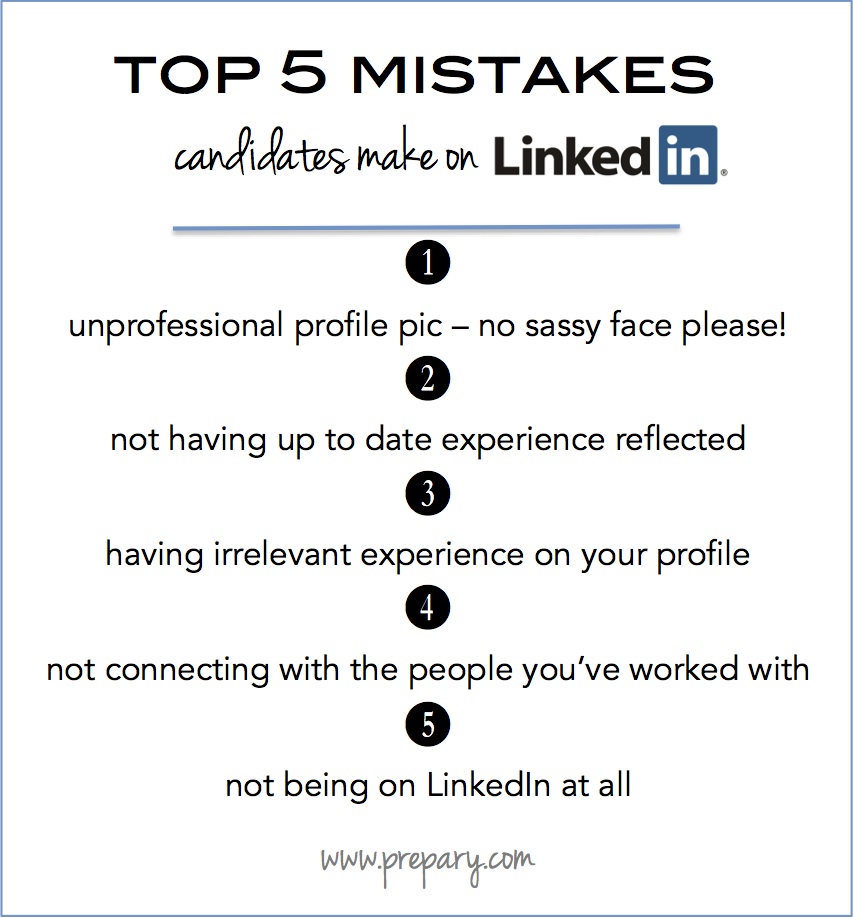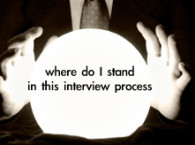As you all know, I’m not a big fan of “what not to do” posts because the job search can be negative enough… so I like to stay positive. However, LinkedIn is a really important tool in today’s recruiting landscape, and while I’m definitely looking forward to writing about the “do’s”, in this case the “don’ts” are pretty important. LinkedIn is VERY visible so it’s important to get your profile in really good shape, even if you’re not that active right now. Here’s my list of the top 5 mistakes candidates make on LinkedIn. Don’t worry, these are all very easily fixed!

1. Have an unprofessional profile picture.
Your LinkedIn profile may be the only place where recruiters have an image associated with your experience (at least before you start interviewing). Your picture on LinkedIn can make a strong impression, so make sure you consider that before you upload. Note: Depending on how a recruiter is using LinkedIn (and what type of user they are) photos may be blocked all together – that’s how it always was for me. Ideally your profile photo will not factor into a hiring decision but if you do choose to use a photo, use these guidelines.
Good LinkedIn profile pictures are:
- Photos of just you (half of your best friend or boyfriend’s face should not be present after cropping)
- Ones where you look polished + professional (neat hair, conservative outfit)
- Ones where you have a simple smile/friendly expression. That mean’s no “sassy face” and model poses!
Pictures that are taken from a night out, have other people in them, or make you look sloppy in any way should be saved for Facebook. On LinkedIn, it can turn recruiters off as it is seen as an indication of how professional you are (or aren’t).
Here’s my rule of thumb if you need a new LinkedIn profile picture. Get dressed, do your hair, etc. like you are heading off to an interview at the company of your choice. Once you’re ready, have someone take a picture of you against a white or simple background. There you have it, a new LinkedIn picture.
Another note: Another option is just not having a profile picture at all. Some people say this counts against you but in my mind, your future employer should care about your experience more than a picture so if you’re not comfortable with having a picture up, skip it!
2. Have missing or incomplete experience
When a recruiter stumbles upon your LinkedIn profile, they need to be able to understand your “story” and the story of your career. If you are missing certain experience (that is relevant to your career) your brand and “story” will be diluted and won’t be as impressive. While you don’t need to update your profile the minute you get a new job, it will be to your benefit to update in a timely manner.
Even if you are not actively looking for a job, it’s important that your LinkedIn profile is up to date. Based on what you’ve done (and the information recruiters have access to) you may be able to make contacts for the future or find out about a life changing opportunity that was never even posted online (but you happen to be perfect for).
3. Having extra information that isn’t relevant
It can also be distracting to have a lot of information that isn’t relevant to “your story”. You might want to remove experience that makes your profile more crowded but doesn’t show off the value you bring to your industry (like that summer you were waiting tables). I know it feels counterintuitive to remove any work experience, but you want your LinkedIn experience to “add up” and make sense in the context of your “career story”.
4. Not connecting with people you’ve worked with in the past
It’s really beneficial to make LinkedIn the place to track your professional contacts. You should constantly be connecting with people you work with (don’t feel awkward). As the years go by, your co-workers will go in different directions, take different career paths, and could be very useful contacts to you one day in the future.
However, you will never be able to keep track of all of your contacts by memory alone (especially as you grow in your own career). LinkedIn truly is the best “social network” for professionals so use it that way and keep track of what people are up to.
5. Not being on LinkedIn
Of course, the biggest mistake of them all is not having a profile on LinkedIn. Your network is something you build over time, not just when you need it. Along those same lines, LinkedIn isn’t something you can just “switch on” and use to your advantage the moment you need it. Rather, it’s something you must build and contribute to over time. Then when you need it, it will be there for you.
So even if you can’t see the point of LinkedIn right now, take my word for it: you will need it someday! So start building today and avoid these common mistakes.





